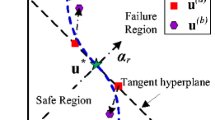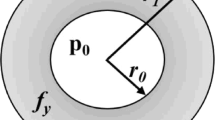Abstract
The stochastic response surface method (SRSM) is widely used in engineering reliability analyses due to its efficiency and accuracy. The selection of collocation points in the SRSM has great significance, as it may strongly affect the computed results. This paper investigates the performance of different selection strategies in SRSM, and proposes a new collocation method. First, two commonly used collocation methods—the regression-based collocation method and the linearly independent collocation method—are briefly reviewed; and their limitations in application to reliability analysis are discussed. Then, an improved collocation method that achieves a better tradeoff between efficiency and accuracy is proposed. Four examples are employed to test the performance of the proposed collocation method; and a comparative study is conducted to demonstrate its advantages with respect to some other existing collocation methods.


Similar content being viewed by others
Abbreviations
- p :
-
Order of PCE
- X :
-
A vector of random variables in physical space
- U :
-
A vector of uncorrelated standard normal random variables
- y :
-
Random output of the model
- Γp(·):
-
Multidimensional Hermite polynomials of order p
- n :
-
Number of random variables in PCE
- a :
-
A vector of unknown coefficients
- T :
-
Hermite polynomial information matrix
- T :
-
Transpose matrix operator
- N a :
-
Number of unknown coefficients
- P i :
-
Selected collocation point
- P ′ i :
-
Symmetric point of Pi with respect to the origin
- ζ :
-
Asymmetrical ratio of the selected collocation points
- Δ:
-
Relative error with respect to MCS or LHS
- N p :
-
Number of selected collocation points or limit state function evaluations
- COV:
-
Coefficient of variation
- P f :
-
Probability of failure
- μ :
-
Mean value
- SD:
-
Standard deviation
- σ t :
-
Applied support pressure at the tunnel face
- σ c,partial :
-
Collapse pressure provided by partial collapse mechanism
- σ c,global :
-
Collapse pressure provided by global collapse mechanism
- σ c,max :
-
Maximum collapse pressure provided by partial collapse or global collapse
- c :
-
Cohesion
- φ :
-
Friction angle
- ρ :
-
Correlation coefficient
References
Hasofer AM, Lind NC (1974) Exact and invariant second-moment code format. J Eng Mech Div 100(1):111–121
Rackwitz R, Flessler B (1978) Structural reliability under combined random load sequences. Comput Struct 9(5):489–494
Breitung K (1984) Asymptotic approximations for multinormal integrals. J Eng Mech 110(3):357–366
Der Kiureghian A, Lin H-Z, Hwang S-J (1987) Second-order reliability approximations. J Eng Mech 113(8):1208–1225
Zeng P, Jimenez R, Li T (2016) An efficient quasi-Newton approximation-based SORM to estimate the reliability of geotechnical problems. Comput Geotech 76:33–42
Rajashekhar MR, Ellingwood BR (1993) A new look at the response surface approach for reliability analysis. Struct Saf 12(3):205–220
Schuëller GI, Stix R (1987) A critical appraisal of methods to determine failure probabilities. Struct Saf 4(4):293–309
Lü Q, Low BK (2011) Probabilistic analysis of underground rock excavations using response surface method and SORM. Comput Geotech 38(8):1008–1021
Lü Q, Sun H-Y, Low BK (2011) Reliability analysis of ground–support interaction in circular tunnels using the response surface method. Int J Rock Mech Min 48(8):1329–1343
Zhang J, Chen H, Huang H, Luo Z (2015) Efficient response surface method for practical geotechnical reliability analysis. Comput Geotech 69:496–505
Isukapalli S, Roy A, Georgopoulos P (1998) Stochastic response surface methods (SRSMs) for uncertainty propagation: application to environmental and biological systems. Risk Anal 18(3):351–363
Li D, Chen Y, Lu W, Zhou C (2011) Stochastic response surface method for reliability analysis of rock slopes involving correlated non-normal variables. Comput Geotech 38(1):58–68
Jiang S-H, Li D-Q, Zhou C-B, Zhang L-M (2014) Capabilities of stochastic response surface method and response surface method in reliability analysis. Struct Eng Mech 49(1):111–128
Huang S, Mahadevan S, Rebba R (2007) Collocation-based stochastic finite element analysis for random field problems. Probab Eng Mech 22(2):194–205
Mollon G, Dias D, Soubra A-H (2011) Probabilistic analysis of pressurized tunnels against face stability using collocation-based stochastic response surface method. J Geotech Geoenviron Eng 137(4):385–397
Wang F, Li H (2017) Stochastic response surface method for reliability problems involving correlated multivariates with non-Gaussian dependence structure: analysis under incomplete probability information. Comput Geotech 89:22–32
Blatman G, Sudret B (2010) An adaptive algorithm to build up sparse polynomial chaos expansions for stochastic finite element analysis. Probab Eng Mech 25(2):183–197
Blatman G, Sudret B (2011) Adaptive sparse polynomial chaos expansion based on least angle regression. J Comput Phys 230(6):2345–2367
Xiong F, Chen W, Xiong Y, Yang S (2011) Weighted stochastic response surface method considering sample weights. Struct Multidiscip Optim 43(6):837–849
Hampton J, Doostan A (2016) Compressive sampling methods for sparse polynomial chaos expansions. Springer International Publishing, New York
Jiang S-H, Li D-Q, Zhou C-B (2012) Optimal probabilistic collocation points for stochastic response surface method. Chin J Comput Mech 29(3):345–351
Li D-Q, Jiang S-H, Cheng Y-G, Zhou C-B (2013) A comparative study of three collocation point methods for odd order stochastic response surface method. Struct Eng Mech 45(5):595–611
Mao N, Al-Bittar T, Soubra A-H (2012) Probabilistic analysis and design of strip foundations resting on rocks obeying Hoek-Brown failure criterion. Int J Rock Mech Min 49:45–58
Xiao T, Li D-Q, Zhou C-B (2014) Non-intrusive reliability analysis of multi-layered slopes using strength reduction FEM. J Basic Sci Eng 22(4):718–732
Webster MD, Tatang MA, McRae GJ (1996) Application of the probabilistic collocation method for an uncertainty analysis of a simple ocean model. In: MIT joint program on the science and policy of global change
Huang SP, Liang B, Phoon KK (2009) Geotechnical probabilistic analysis by collocation-based stochastic response surface method: an excel add-in implementation. Georisk Assess Manag Risk Eng Syst Geohazards 3(2):75–86
Li H, Zhang D (2007) Probabilistic collocation method for flow in porous media: comparisons with other stochastic methods. Water Resour Res 43(9):W09409. https://doi.org/10.1029/2006WR005673
Sudret B (2008) Global sensitivity analysis using polynomial chaos expansions. Reliab Eng Syst Saf 93(7):964–979
Grooteman F (2008) Adaptive radial-based importance sampling method for structural reliability. Struct Saf 30(6):533–542
Periçaro G, Santos S, Ribeiro A, Matioli L (2015) HLRF–BFGS optimization algorithm for structural reliability. Appl Math Model 39(7):2025–2035
Ranganathan R (1999) Structural reliability analysis and design. Jaico Publishing House, Mumbai
Santosh T, Saraf R, Ghosh A, Kushwaha H (2006) Optimum step length selection rule in modified HL–RF method for structural reliability. Int J Press Vessels Pip 83(10):742–748
Nguyen XS, Sellier A, Duprat F, Pons G (2009) Adaptive response surface method based on a double weighted regression technique. Probab Eng Mech 24(2):135–143
Mollon G, Dias D, Soubra AH (2011) Rotational failure mechanisms for the face stability analysis of tunnels driven by a pressurized shield. Int J Numer Anal Methods Geomech 35(12):1363–1388
Senent S, Jimenez R (2015) A tunnel face failure mechanism for layered ground, considering the possibility of partial collapse. Tunn Undergr Space Technol 47:182–192
Phoon KK (2008) Reliability-based design in geotechnical engineering: computations and applications. Taylor & Francis, New York
Acknowledgements
This research was supported by the National Natural Science Foundation of China (Project nos. 41602304 and 41772329), the Sichuan Science and Technology Program (Project No. 2019YJ0405), the State Key Laboratory of Geohazard Prevention and Geoenvironment Protection (Project no. SKLGP2016Z003) and the Spanish Ministry of Economy and Competitiveness (Project no. BIA2015-69152-R). Their support is greatly appreciated.
Author information
Authors and Affiliations
Corresponding author
Additional information
Publisher's Note
Springer Nature remains neutral with regard to jurisdictional claims in published maps and institutional affiliations.
Electronic supplementary material
Below is the link to the electronic supplementary material.
366_2019_793_MOESM1_ESM.rar
Supplementary material 1 (RAR 98 kb) Supplementary materials Supplementary data associated with the selected collocation points for LICM, RBCM and SFRCM (up to the 6th order PCE and up to 10 random variables)
Rights and permissions
About this article
Cite this article
Zeng, P., Li, T., Chen, Y. et al. New collocation method for stochastic response surface reliability analyses. Engineering with Computers 36, 1751–1762 (2020). https://doi.org/10.1007/s00366-019-00793-2
Received:
Accepted:
Published:
Issue Date:
DOI: https://doi.org/10.1007/s00366-019-00793-2




